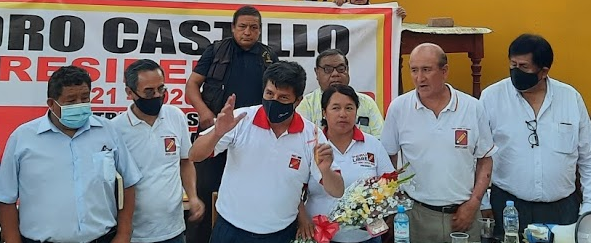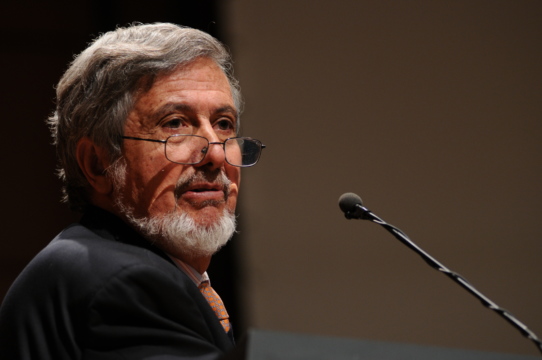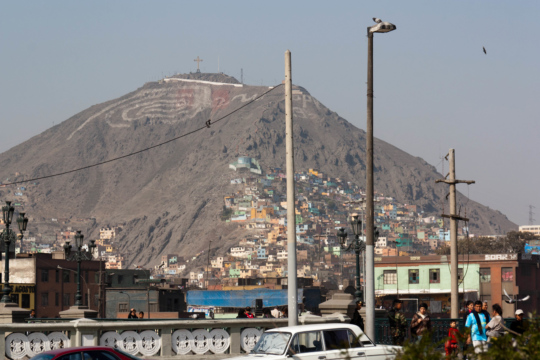Peru’s Election and Beyond: What’s Next?
Peruvians want an evolution, not a revolution.
A Daily Publication of The Dialogue
Far-left candidate Pedro Castillo emerged as the top vote-getter in the first round of Peru’s presidential election on Sunday. In the June runoff, it appears that he will face right-wing former legislator Keiko Fujimori, who looks to have come in second, ahead of opponents Rafael López Aliaga and Hernando de Soto. What accounts for Castillo’s unexpected first-round lead, and how will that shape the second round? What are Castillo’s most important proposals, and why did they resonate with voters? With far-left and far-right candidates in the running, is there a risk that political extremism will come to dominate Peru’s politics in the coming years?
Cynthia McClintock, professor of political science and international affairs at The George Washington University: “The two candidates at ideological extremes who reached Peru’s runoff expose the abyss between the ‘two Perus’—the coast, including Lima, where globalization and progress have been considerable, and Peru’s interior, where citizens have felt abandoned and angry, and only more so during the pandemic. A schoolteacher in the highlands department of Cajamarca, Castillo has never held elective office; his leadership of a major teachers’ strike in 2017 led to grassroots support in remote highland areas (which pollsters did not visit until the final days of election campaigns). Castillo has proposed a new constitution; state intervention of companies in the mining, energy and other sectors; the replacement of the Constitutional Tribunal (Peru’s highest court) with a popularly elected court; and (like almost every candidate) dramatic increases in resources for education and health. On social issues, he is conservative. Critics have charged that Castillo has ties to Shining Path’s political arm, which he denies. On the campaign trail, Castillo is lucid—not a firebrand—and it is possible that his positions will moderate. Indeed, at one time he was a candidate for a mayoralty for Alejandro Toledo’s moderate party. He swept the highlands vote, even defeating mainstream leftist candidate Verónika Mendoza in her Cusco base. By contrast, rightist candidates—Keiko, de Soto and López Aliaga—swept the coastal vote. Extremes prevailed because the ‘muddy middle’ was disgusted by mainstream politicians’ corruption and pre-occupied by the devastating—and yet worsening—pandemic. At more than 25 percent, absenteeism was unprecedented. In addition, candidates could not campaign conventionally, and citizens could not meet to assess them; the large field failed to narrow sufficiently, and it was not possible to know which moderate candidate had a chance. Peru’s highly fragmented legislature will include ideological extremes; legislatures can impeach presidents on the vague grounds of ‘moral incapacity.’ The risks of extremism and instability are high.”
Jo-Marie Burt, associate professor at the Schar School of Policy and Government at George Mason University and senior fellow at the Washington Office on Latin America: “Pedro Castillo’s surprise victory is similar in many ways to that of Alberto Fujimori in the first-round elections in 1990. Neither Castillo nor Fujimori registered in public-opinion polls and only emerged as real contenders just weeks before the first-round vote. In both cases, their meteoric rise was rooted in a context of intense economic, social and political crisis. Castillo’s first-round victory is rooted in a crisis of political representation not dissimilar from the one that brought Fujimori to power in 1990, mediated not by an insurgency but rather by Covid-19. The failure of the Peruvian state to mount a meaningful response to the pandemic, leaving families to fend for themselves in the face of overcrowded public hospitals and price gouging for life-saving oxygen and medicines, has also fueled voter discontent. The result: Peru has one of the world’s highest Covid fatality rates. Peru’s economy, once lauded for its record-breaking levels of growth, has tanked, largely because of the pandemic, fueling inequality and hunger. Last year, Peru’s Congress ousted a sitting president, fueling a political crisis in the midst of the pandemic, leaving Peruvians distraught at the opportunism of their political leaders. Postponing the elections would have been reasonable in this context. The scant legitimacy of Peru’s democratic institutions meant that this was not seriously considered, pushing the country, zombie-like, toward elections despite the surging rates of Covid infections and deaths. Castillo’s anti-establishment discourse appeals to Peruvians left behind by Peru’s neoliberal ‘miracle,’ abandoned by Peru’s anemic state and treated like second-class citizens because of the color of their skin. He articulates an idea every Peruvian learns as a child: Peru is a poor country, sitting on a pile of gold. He promises to change all of this. More than his professed Marxism or his admiration for Fidel Castro, this is what led to his rapid rise among a fragmented field of candidates to make him a contender for the presidency of Peru.”
Rocío Verástegui, professor in the Department of Social Sciences and the School of Government at Pontificia Universidad Católica del Perú: “Understanding the electoral results in Peru allows us to understand the country as a whole, and what citizens expect from their representatives. My hypothesis about support surrounding a leader such as Castillo in the first round is related to the issues that have been left pending in Peruvian democracy over the years (and perhaps also in other democracies)—a democracy that does not take into account all its citizens and does not guarantee rights. The right to life in the context of the coronavirus pandemic, and the right to health and education, are voters’ great demands, combined with a questioning of corruption and extreme inequality. Since the 2006 elections, in an investigation I conducted, I found similar electoral maps that showed voters’ demand for rights. Castillo’s claim, ‘No more poverty in a rich country,’ resonates with his voters, and his experience as a patrol leader and public-school teacher connects with a large part of the population. His main proposals are a constitutional change and a new economic model that promotes a greater presence of the state. Peru has the opportunity to reflect and recognize itself, to listen to citizens, to think of a decentralized country, to listen to our diversity and strengthen our citizenship, even when the risk of polarization is present, as the population has resorted to ideological extremes in order to kick out corruption and social precariousness.”
Nicolás Saldías, analyst for Latin America and the Caribbean at The Economist Intelligence Unit: “Although Pedro Castillo saw last-minute growth in support, his victory in the first round was unexpected. His electoral triumph is largely a result of a highly fragmented field of 18 presidential candidates and widespread disenchantment with the political class that allowed an outsider like Castillo to become a viable candidate for the presidency. Castillo’s rise came at the cost of mainstream left-of-center candidates, such as Yonhy Lescano of Acción Popular and Verónika Mendoza of Juntos por el Perú. What set Castillo apart was his activism in the labor movement (gaining prominence as a union leader during the 2017 teachers’ strike), his working-class roots and style, his in-person campaigning, as well as his mixture of statist policies and socially conservative stances. Castillo’s policies include a constitutional reform by summoning a constituent assembly, threatening to nationalize strategic sectors of the economy, such as mining, as well as revising or pulling out of Peru’s free trade agreements. If enacted, it would represent a rejection of Peru’s orthodox economic model. Recent polls show that most Peruvians want the state to play a larger role in the economy, but it seems unlikely they would endorse such radical statist policies. Castillo will face Keiko Fujimori in the runoff. She has diametrically opposed economic policies and will utilize long-standing animus toward the left by a portion of the population to garner support. As a result, the likelihood of political destabilization is high leading up to the June 6 runoff and beyond.”
Will Freeman, PhD student in politics at Princeton University: “Peru’s presidential contenders occupy the political extremes, and many will see their strong performance in the first round as a harbinger of crisis. But the truth is Peru is already in crisis and has been for years. The country’s volatile political parties habitually fail to channel citizen demands, often acting as thinly veiled fronts for corrupt business interests or organized crime. National political institutions have no effective mechanisms of subduing interbranch conflict. Despite Peru’s macroeconomic stability, public health and education remain painfully deficient, especially far from Lima, as the pandemic has made all too clear. The strong performance of anti-system candidates is a symptom of democratic decay, not just a potential cause. The fact that 17.6 percent of Peruvians voted blank or spoiled their ballots, second only to the share who supported Castillo, drives the point to home. Castillo has promised to fight for ‘forgotten Peruvians’ who live ‘where there is no presence of the state,’ to replace the existing constitution even if it means dissolving Congress and to increase state intervention in the economy and investment in education. For many Peruvians, politics as usual barely functions, so it shouldn’t be surprising his message resonated. Like all too many recent elections in the region, the June runoff will force most voters to decide which candidate they dislike the least. With good reason, many fear that Keiko Fujimori would use the presidency to free her father from jail and concentrate power. Against any other of the first-round candidates, she would almost certainly have lost, but facing Castillo, who praises Venezuela’s Maduro in a country still processing the scars of Sendero Luminoso, she faces a unique advantage. Still, Peruvians may choose to gamble on an uncertain future with Castillo rather than an all too certain return to the past.”
 The Latin America Advisor features Q&A from leaders in politics, economics, and finance every business day. It is available to members of the Dialogue’s Corporate Program and others by subscription.
The Latin America Advisor features Q&A from leaders in politics, economics, and finance every business day. It is available to members of the Dialogue’s Corporate Program and others by subscription.
Peruvians want an evolution, not a revolution.
With the recent decline in commodity prices, why have some countries have fared better than others?
Peru’s growing urban middle class is one of the country’s greatest assets, but it also brings political and governance challenges.
 Pedro Castillo (center) won the most votes in the first round of Peru’s presidential election.
// File Photo: Castillo Campaign.
Pedro Castillo (center) won the most votes in the first round of Peru’s presidential election.
// File Photo: Castillo Campaign.

